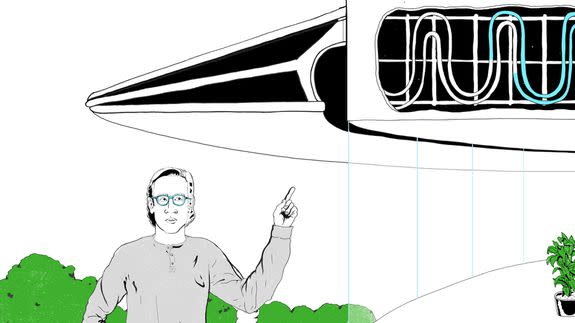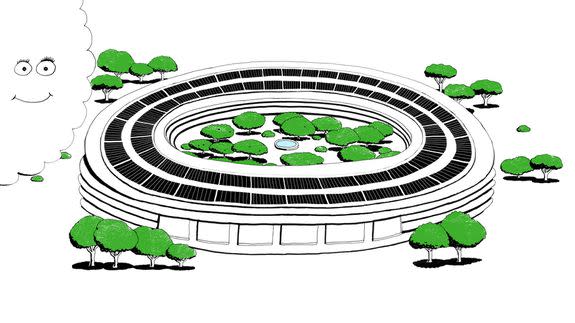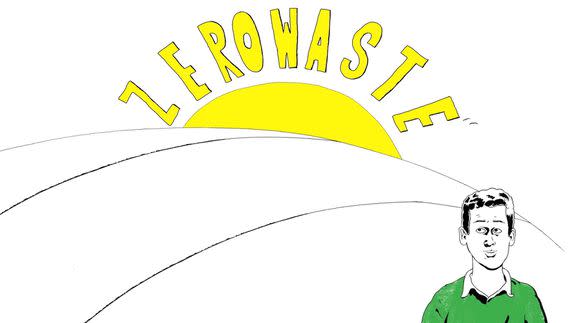Apple’s new Earth Day videos are the least Apple thing ever

I’m laughing. While watching an Apple video. That’s not normal.
A typical Apple promotional video has a type: Clean, dispassionate, slightly British (thanks Jony Ive) and self-congratulatory. It’s not quirky, whimsical, or funny.
But each of the four short animated stories detailing Apple’s efforts to become a 100 percent renewable company and released just a few days before Earth Day, are unlike anything Apple has produced before.
What’s more interesting is that the audio is 100 percent true and, taken by itself, not particularly funny. But when combined with the hand-drawn animation from illustrator James Blagden the stories become whimsical and even a little odd.
SEE ALSO: Your iPhone's camera could one day scan a room to pick out faces
The standout is a roughly minute-long spot called “Why Does Apple Make its Own Sweat?” In it Apple’s Environmental Technologies Group lead Rob Guzzo explains how and why Apple chose to stop buying artificial sweat and started creating its own. Guzzo, who is depicted in the cartoon, offers a pretty straight forward account of the decisions, but Blagden’s animation embellishes with images of armpits and even one of an Apple lab tech tasting the artificial sweat.

Image: James Blagden/apple
“We knew from the start that we wanted this to be engaging in a different way to tell the stories,” said Apple VP of Environment, Policy & Social Initiatives Lisa Jackson.
Jackson told me that simply explaining what Apple’s doing in the environmental space doesn’t really convey the work or the people behind it. The goal of the animations is to boil it down and make the complex work of environmentalism more tangible and digestible and to highlight the “unsung” people doing the work.
However, it’s the unusual blend of unscripted Apple employees’ voices, including Jackson’s, and the whimsical visuals that really transforms the spots. “When it’s unscripted and in their own voice, people tend to pay attention and just get it,” she said.
Bladgen, who is probably best known for his Dock Ellis & The LSD No-No short on how a Major League Baseball pitcher threw a no-hitter while on LSD, still sounded surprised at some of the places Apple let him take the visuals.
“I didn’t think the bit where he tastes the sweat, I didn’t think they were going to go for it,” laughed Blagden, who told me he prefers drier material like the Apple environmental story and then finding the humor in it.
For the story of Apple’s solution for accommodating solar panels and grazing yaks in China, Bladgen perfectly illustrated Apple’s solution: putting the solar panels higher so the light could reach them and the ground below. However, he also put a yak at a dinner table, eating grass with a fork. When Jackson, who narrates the spot (an animated version of her appears in it), mentions the need for creative solutions, Blagden illustrated her and the yak painting portraits of each other.
“One of the coolest things that will ever happen to me: hip artist James Blagden rendering how I will look in his world,” said Jackson.

Image: James Blagden/apple
There’s even a “Where’s Waldo” element to the four spots, with an animated Apple CEO Tim Cook popping up in each video. In one, he’s inside the new and soon-to-be-opened Apple Park, which relies on cooled water and air circulated from the outside for air conditioning, breathing in the office's fresh air.
Blagden, who spent four months working on the animations, couldn’t recall whose idea it was for all the Cook cameos, but he does recall that when Apple execs had to present the unusual collection of videos to Cook. “I know there was a big meeting with him where he signed off, it was a pretty big deal. Everyone was really nervous,” he said.
Perhaps Cook signed off because he, knew that now is the time for something different.
Jackson, who served as the head of the Environmental Protection Agency from 2009 to 2013, an agency that is being gutted by President Donald Trump's administration (there are proposals to cut its budget by at least 31%), wouldn’t address President Trump directly. But there’s a recognition that the stakes are higher this year and a new, more in-your-face approach to environmental story-telling is necessary.

Image: james bladgen/apple
“What we knew we wanted this year more than ever, in this time, to connect people to environmental story,” said Jackson.
Apple and businesses like it have a huge role to play in leadership, she said.
“We’re not walking away from that," Jackson said.
In Silicon Valley, Apple is known for setting ambitious environmental goals, while still facing many of the same challenges that plague the industry overall, namely supply chain pollution, rare Earth mineral use, and data center energy consumption.
While the videos focus on some of the smaller stories in Apple’s environmental efforts, its goals remain, for lack of a better word, huge.
The California tech giant powers nearly all its data centers, offices, and retail stores worldwide with renewable energy. About 96 percent of its direct electricity use came from wind, solar, and other clean sources in 2016, the company said in its latest environmental progress report.
However, that doesn’t cover all the carbon emissions related to manufacturing iPhones, iPads, and other Apple products. About 77 percent of the company’s total carbon footprint comes from manufacturing sites and companies that Apple neither owns nor directly operates, the company said in 2016.
Jackson said the company is focused on tackling climate change, and not just through its own efforts.
“If we zeroed out our carbon footprint ... that would not solve the problem. We need businesses and people running on clean energy… The only way to tackle climate change, it has to be bigger than what we can do,” said Jackson.
With so much progress made on the renewable energy side, Apple is now attacking the much trickier carbon footprint of its supply chain.
That’s why Apple is pushing its partners to jump on the clean energy bandwagon, too. Seven of Apple’s major suppliers have pledged to power their Apple production entirely with renewable energy by the end of 2018. Together, Apple and its suppliers will generate or purchase more than 4,000 megawatts of new renewable energy globally by 2020, half of which will be built in China.
These efforts are already starting to pay off. In 2016, Apple’s comprehensive carbon footprint was 29.5 million metric tons – a 23 percent drop from 2015’s total of 38.4 million tons. Still, there is a long way for the company to go when it comes to becoming a 100 percent renewable company, and more challenges to tackle too, including the use of rare earth minerals and the e-waste problem.
On Thursday, Apple became the first major IT company to commit to using 100 percent recycled materials for its products, though it is not clear how quickly it will be able to accomplish this.
The company has also made an effort to reclaim materials from used iPhones. Last year, Apple unvield LIAM, the 29-armed recycling robot that dismantles used iPhone 6 devices.

Image: james bladgen/apple
In one video entitled “Can We Produce Zero Waste,” John Reynolds who works in Apple’s iPhone Product Operations, finds that Apple’s factories are discarding towers of pallets. His initial solution is to recycle them. In the video, Reynolds recounts how he got his wrist slapped by Apple execs for not going far enough. Apple wants to eliminate waste in the production of its popular products. The video ends, though, without a resolution.
“Their solution is that there actually are many of our final assembly facilities, in China, U.S., Cork, Ireland, all certified by UL as zero waste,” said Jackson.
The job of finding smart, safe ways to test and manufacturer Apple’s new products falls, in part, on Rob Guzzo. His Environmental Technologies Group, which is part of Apple’s Hardware Engineering Division, is responsible for supporting environmental initiatives on Apple’s products. Guzzo defines his group’s responsibilities as mitigating the impact of climate change, reducing dependency on finite resources and using safer materials.
Apple needs artificial sweat, Guzzo explained, because, “One of the most important elements of products, from safety perspective, are those that are contact with skin for a long time.” Apple Pencil, AirPods and Apple Watch top that list.
Testing with sweat is a great way to simulate human wear, but collecting real human sweat was deemed impractical and “gross.”
For a time, the company purchased frozen artificial sweat, but they soon realized it made more sense to create it in house. The mixture is purified water, salt, lactic acid and urea. Each day, a lab tech produces a half gallon.

Image: James blagden/apple
Guzzo said having their own “sweat supply” and in-house toxicologists to analyze the effect of the solution on product materials (usually they test on pre-production models) means that the results can be used to influence final designs and materials.
It’s a fascinating story, but depicted in more entertaining fashion in the video where the guy who makes the sweat wears a “Sweat Guy” hat and holds up an Eeu de Sweat perfume bottle – all Blagden touches.
“I never would have imagined that the creative minds at Apple would have been able to come up with a video like that to tell the story about making sweat,” Guzzo told me.
Jackson hopes that Apple’s weird videos engage a new audience.
“We prefer to say unique, not weird, but we’ll take weird as long as funny is included. You never know when you’re going to spark the imagination and intelligence of next environmentalist.”
Jackson believes Apple can set an environmental example for others even as the EPA relinquishes its leadership role.
“There’s a parade going on to cleaner and low carbon economy. Apple is in the parade, as are businesses, states, cities, activists. Having worked at EPA for more than two decades, it would be great if EPA assumed its normal spot at head of parade, but parade is moving on either way.”
Andrew Freedman and Maria Gallucci contributed reporting.